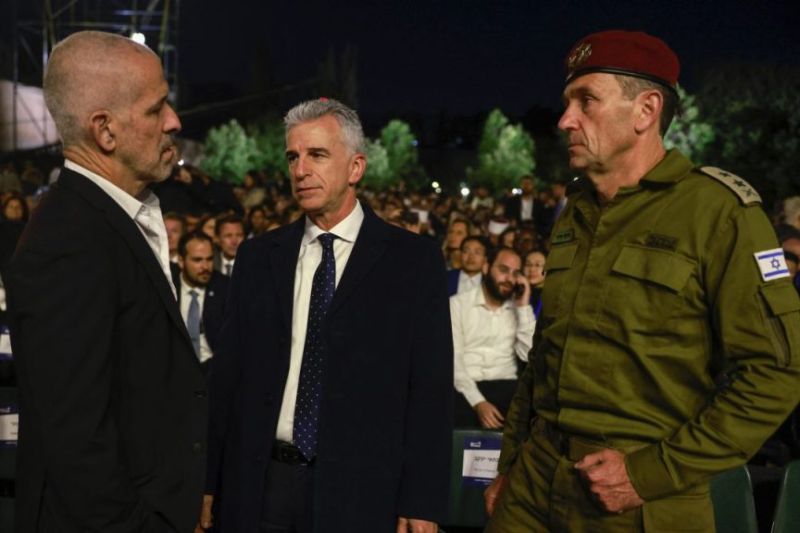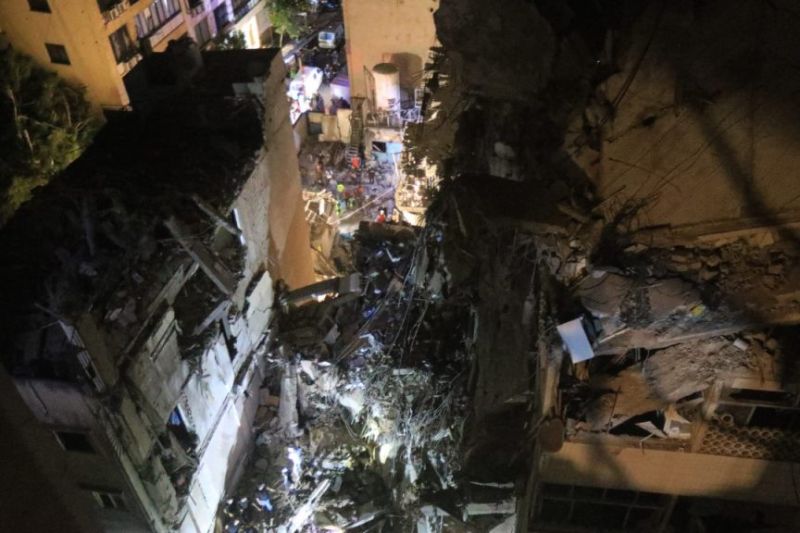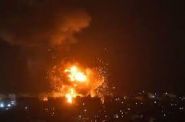- Home
- War in the Middle East
- Israeli Intelligence, the Nemesis of Pro-Iranian Axis

A thunderbolt struck on the morning of July 31: Hamas leader Ismail Haniyeh, visiting Tehran to attend the inauguration ceremony of Iranian President Massoud Pezeshkian, was killed in a strike, which was likely carried out by Israel. This was the second assassination of a high-ranking member of the Iranian axis in 48 hours. The previous day, Fouad Shokr, head of Hezbollah's military wing, was killed in the southern suburbs of Beirut.
While a significant escalation of regional tensions is feared, this new development highlights the methods of the Israeli intelligence community: the Mossad, Aman and, to a lesser extent, the Shin Bet.
Translated from Hebrew as "Institute," the Mossad was created in the context of the founding of the State of Israel in 1949. Its primary mission is to collect intelligence, conduct covert operations abroad, and prevent threats against Israel. It is also responsible for the security of Jewish communities worldwide.
Unlike its domestic and military counterparts, the objectives, structure and powers of this agency are exempt from all of Israel's basic laws. Its director is accountable only to the Israeli prime minister. Currently, this position is held by David Barnea, who gained media attention for his participation in ceasefire negotiations in Gaza.
 (L-R) Israel's domestic security agency 'Shin Bet' chief Ronen Bar, Mossad Director David Barnea, and army Chief of Staff Herzi Halevi talk as they arrive for a ceremony marking Holocaust Remembrance Day for the six million Jews killed during World War II, at the Yad Vashem Holocaust Memorial in Jerusalem on May 5, 2024. (Menahem Kahana / AFP)
(L-R) Israel's domestic security agency 'Shin Bet' chief Ronen Bar, Mossad Director David Barnea, and army Chief of Staff Herzi Halevi talk as they arrive for a ceremony marking Holocaust Remembrance Day for the six million Jews killed during World War II, at the Yad Vashem Holocaust Memorial in Jerusalem on May 5, 2024. (Menahem Kahana / AFP)
The structure of the organization is kept secret, but certain specialized departments, each with distinct responsibilities, are known to the media.
It is mainly its clandestine operations and assassinations that have earned the Mossad a solid reputation. The most famous example was the capture and extradition from Argentina of former Nazi official Adolf Eichmann in 1960.
Acronym for Agaf ha-Modi'in (meaning "the Intelligence Section"), Aman is the branch responsible for intelligence gathering within the Israeli army. This branch is independent from the other armed forces, with an estimated personnel of around 7,000 people.
Unlike the Mossad, this service is integrated into the army structure and thus reports first to the Israeli army's general staff, which in turn reports to the prime minister.
This branch aims to provide the Israeli government with detailed intelligence on a national level. Aman can also conduct cross-border operations involving its own special forces units, the Sayeret Matkal.
Aman has three main subdivisions, the most famous of which is probably Unit 8200, dedicated to cyber warfare, electronic intelligence and advanced surveillance. It is known for its cutting-edge technological capabilities.
Also known by the acronym Shabak (for "Israeli Security Agency"), this is Israel's domestic security agency. Founded in 1949, Shin Bet is primarily responsible for counter-terrorism and combating other covert activities that threaten Israel's security.
Additionally, this agency is responsible for the personal protection of senior officials, the security of important infrastructure and government buildings, as well as protecting embassies abroad.
Unlike the Mossad, it operates mainly within Israel's borders and in the Palestinian territories – generally in coordination with Aman.
The primary function of these three agencies remains intelligence gathering – that is, the collection, analysis and exploitation of information to ensure security and achieve the goals of the Hebrew state. Intelligence gathering precedes any covert actions, such as the assassinations that occurred this week.
HUMINT (Human Intelligence) can be considered the "traditional" method, involving the use of human agents to collect information.
Next comes SIGINT (Signals Intelligence), which focuses on intercepting electronic communications, including phone calls, emails and other forms of digital communication. SIGINT also includes the monitoring of electromagnetic waves, such as radar waves.
IMINT (Imagery Intelligence) relies on the study of information obtained through aerial or satellite photography. It is generally complemented by MASINT (Measurement and Signature Intelligence), which includes other forms of detection.
Finally, OSINT (Open Source Intelligence) is based on the collection of information from publicly available sources, such as media, publications, online forums or mapping services.
The scope of the means employed varies according to the agency. However, cooperation among the three agencies allows them to benefit from each other's resources.
Once cross-referenced, the information obtained by these different means allows Israeli agencies to set up an operation aimed at eliminating targeted individuals. Since October 7, several leaders of the pro-Iranian axis have fallen victim to these measures, both in Gaza and the West Bank, as well as in Syria and Lebanon.
In these territories, which can be described as the immediate environment of the Hebrew state, air power remains the preferred means (Fighter jets, drones, etc.). Once the target is located, the used vector drops a guided munition on it. Due to the involvement of the Israeli army, Aman usually plays a significant role in such operations, often in coordination with one of the other two agencies.
 A photo taken on July 30, 2024 shows the destroyed upper floors of a building following an Israeli military strike in the southern suburbs of Beirut. (AFP)
A photo taken on July 30, 2024 shows the destroyed upper floors of a building following an Israeli military strike in the southern suburbs of Beirut. (AFP)
When operations take place outside Israel's immediate borders, particularly on the territory of its archenemy, the Islamic Republic of Iran, the Mossad often takes the lead, using more discreet methods such as poisoning, bombings or firearms to eliminate the targets. For instance, Israel has carried out a campaign of assassinations against scientists linked to the Iranian nuclear program.
The penultimate example, that of Professor Mohsen Fakhrizadeh in November 2020, stands out for the sophistication of the means employed. According to The New York Times, the weapon used was a remotely controlled machine gun, assisted by artificial intelligence for facial recognition. The entire apparatus weighed about a ton and had been clandestinely introduced into Iran in small pieces before the operation, then reassembled.
The assassinations of Fouad Shokr and Ismail Haniyeh were therefore carried out using appropriate methods. The Hezbollah leader was killed in an airstrike on Tuesday, July 30, notably after an agent on the ground confirmed his location in Dahyeh, according to An-Nahar newspaper.
A confirmation of the Hebrew state's HUMINT capabilities, which were undoubtedly cross-referenced with SIGINT, according to an analysis by Pierre-Henri "Até" Chuet, a former French naval aviator and defense specialist, in a video published on YouTube on Wednesday.
However, the information held by Israeli intelligence could be even more precise, according to the latter. Indeed, their rapid response after the bombing of Majdal Shams on July 27 suggests that the Hebrew state already had information about Shokr's location.
The same question arises in the case of Ismail Haniyeh's death. While initial hypotheses pointed to an airstrike – or even a missile fired from a submarine – information reported Thursday by The New York Times pointed in a completely different direction.
[readmore url="https://thisisbeirut.com.lb/world/278011"]
According to the American media, the former head of Hamas's political bureau was assassinated by an explosive device that had been clandestinely introduced and placed in his residence in Tehran, which was protected and fortified by the Islamic Revolutionary Guard Corps, Tehran's ideological army. Notably, this bomb had been hidden nearly two months in advance.
Less spectacular than a machine gun controlled by AI, this attack is nevertheless remarkable for the complexity of its level of preparation. Israeli intelligence – very likely the Mossad – was able to identify security flaws in the complex and prepare the attack gradually, probably using colossal means. Not to mention a capacity for anticipation that leaves this case with more questions than answers.
Voir cette publication sur Instagram
While a significant escalation of regional tensions is feared, this new development highlights the methods of the Israeli intelligence community: the Mossad, Aman and, to a lesser extent, the Shin Bet.
The star: the Mossad
Translated from Hebrew as "Institute," the Mossad was created in the context of the founding of the State of Israel in 1949. Its primary mission is to collect intelligence, conduct covert operations abroad, and prevent threats against Israel. It is also responsible for the security of Jewish communities worldwide.
Unlike its domestic and military counterparts, the objectives, structure and powers of this agency are exempt from all of Israel's basic laws. Its director is accountable only to the Israeli prime minister. Currently, this position is held by David Barnea, who gained media attention for his participation in ceasefire negotiations in Gaza.
 (L-R) Israel's domestic security agency 'Shin Bet' chief Ronen Bar, Mossad Director David Barnea, and army Chief of Staff Herzi Halevi talk as they arrive for a ceremony marking Holocaust Remembrance Day for the six million Jews killed during World War II, at the Yad Vashem Holocaust Memorial in Jerusalem on May 5, 2024. (Menahem Kahana / AFP)
(L-R) Israel's domestic security agency 'Shin Bet' chief Ronen Bar, Mossad Director David Barnea, and army Chief of Staff Herzi Halevi talk as they arrive for a ceremony marking Holocaust Remembrance Day for the six million Jews killed during World War II, at the Yad Vashem Holocaust Memorial in Jerusalem on May 5, 2024. (Menahem Kahana / AFP)The structure of the organization is kept secret, but certain specialized departments, each with distinct responsibilities, are known to the media.
It is mainly its clandestine operations and assassinations that have earned the Mossad a solid reputation. The most famous example was the capture and extradition from Argentina of former Nazi official Adolf Eichmann in 1960.
Aman, the ears of the Israeli army
Acronym for Agaf ha-Modi'in (meaning "the Intelligence Section"), Aman is the branch responsible for intelligence gathering within the Israeli army. This branch is independent from the other armed forces, with an estimated personnel of around 7,000 people.
Unlike the Mossad, this service is integrated into the army structure and thus reports first to the Israeli army's general staff, which in turn reports to the prime minister.
This branch aims to provide the Israeli government with detailed intelligence on a national level. Aman can also conduct cross-border operations involving its own special forces units, the Sayeret Matkal.
Aman has three main subdivisions, the most famous of which is probably Unit 8200, dedicated to cyber warfare, electronic intelligence and advanced surveillance. It is known for its cutting-edge technological capabilities.
Shin Bet, the domestic intelligence
Also known by the acronym Shabak (for "Israeli Security Agency"), this is Israel's domestic security agency. Founded in 1949, Shin Bet is primarily responsible for counter-terrorism and combating other covert activities that threaten Israel's security.
Additionally, this agency is responsible for the personal protection of senior officials, the security of important infrastructure and government buildings, as well as protecting embassies abroad.
Unlike the Mossad, it operates mainly within Israel's borders and in the Palestinian territories – generally in coordination with Aman.
Intelligence gathering
The primary function of these three agencies remains intelligence gathering – that is, the collection, analysis and exploitation of information to ensure security and achieve the goals of the Hebrew state. Intelligence gathering precedes any covert actions, such as the assassinations that occurred this week.
HUMINT (Human Intelligence) can be considered the "traditional" method, involving the use of human agents to collect information.
Next comes SIGINT (Signals Intelligence), which focuses on intercepting electronic communications, including phone calls, emails and other forms of digital communication. SIGINT also includes the monitoring of electromagnetic waves, such as radar waves.
IMINT (Imagery Intelligence) relies on the study of information obtained through aerial or satellite photography. It is generally complemented by MASINT (Measurement and Signature Intelligence), which includes other forms of detection.
Finally, OSINT (Open Source Intelligence) is based on the collection of information from publicly available sources, such as media, publications, online forums or mapping services.
The scope of the means employed varies according to the agency. However, cooperation among the three agencies allows them to benefit from each other's resources.
Targeted assassinations
Once cross-referenced, the information obtained by these different means allows Israeli agencies to set up an operation aimed at eliminating targeted individuals. Since October 7, several leaders of the pro-Iranian axis have fallen victim to these measures, both in Gaza and the West Bank, as well as in Syria and Lebanon.
In these territories, which can be described as the immediate environment of the Hebrew state, air power remains the preferred means (Fighter jets, drones, etc.). Once the target is located, the used vector drops a guided munition on it. Due to the involvement of the Israeli army, Aman usually plays a significant role in such operations, often in coordination with one of the other two agencies.
 A photo taken on July 30, 2024 shows the destroyed upper floors of a building following an Israeli military strike in the southern suburbs of Beirut. (AFP)
A photo taken on July 30, 2024 shows the destroyed upper floors of a building following an Israeli military strike in the southern suburbs of Beirut. (AFP)When operations take place outside Israel's immediate borders, particularly on the territory of its archenemy, the Islamic Republic of Iran, the Mossad often takes the lead, using more discreet methods such as poisoning, bombings or firearms to eliminate the targets. For instance, Israel has carried out a campaign of assassinations against scientists linked to the Iranian nuclear program.
The penultimate example, that of Professor Mohsen Fakhrizadeh in November 2020, stands out for the sophistication of the means employed. According to The New York Times, the weapon used was a remotely controlled machine gun, assisted by artificial intelligence for facial recognition. The entire apparatus weighed about a ton and had been clandestinely introduced into Iran in small pieces before the operation, then reassembled.
Exceptional capabilities
The assassinations of Fouad Shokr and Ismail Haniyeh were therefore carried out using appropriate methods. The Hezbollah leader was killed in an airstrike on Tuesday, July 30, notably after an agent on the ground confirmed his location in Dahyeh, according to An-Nahar newspaper.
A confirmation of the Hebrew state's HUMINT capabilities, which were undoubtedly cross-referenced with SIGINT, according to an analysis by Pierre-Henri "Até" Chuet, a former French naval aviator and defense specialist, in a video published on YouTube on Wednesday.
However, the information held by Israeli intelligence could be even more precise, according to the latter. Indeed, their rapid response after the bombing of Majdal Shams on July 27 suggests that the Hebrew state already had information about Shokr's location.
The same question arises in the case of Ismail Haniyeh's death. While initial hypotheses pointed to an airstrike – or even a missile fired from a submarine – information reported Thursday by The New York Times pointed in a completely different direction.
[readmore url="https://thisisbeirut.com.lb/world/278011"]
According to the American media, the former head of Hamas's political bureau was assassinated by an explosive device that had been clandestinely introduced and placed in his residence in Tehran, which was protected and fortified by the Islamic Revolutionary Guard Corps, Tehran's ideological army. Notably, this bomb had been hidden nearly two months in advance.
Less spectacular than a machine gun controlled by AI, this attack is nevertheless remarkable for the complexity of its level of preparation. Israeli intelligence – very likely the Mossad – was able to identify security flaws in the complex and prepare the attack gradually, probably using colossal means. Not to mention a capacity for anticipation that leaves this case with more questions than answers.
Read more




Comments